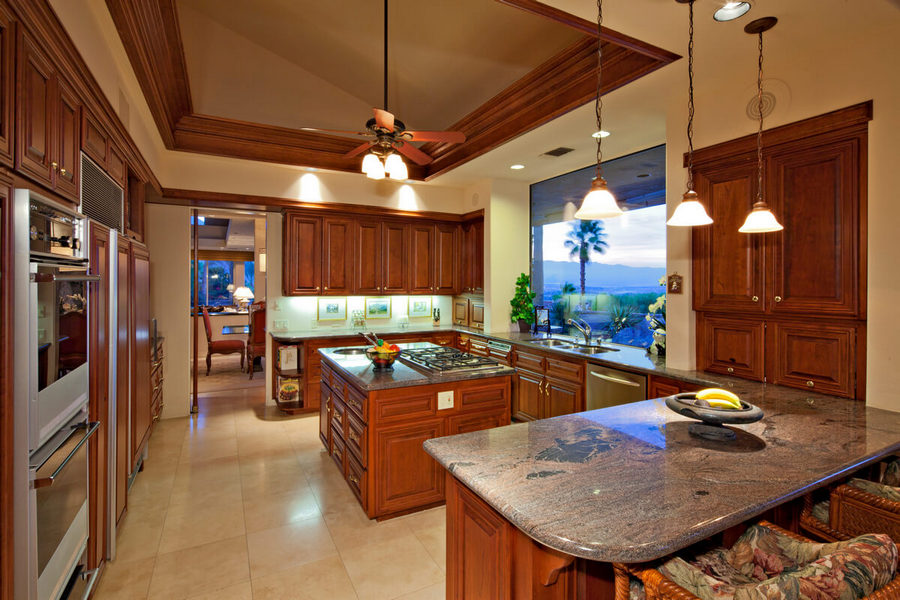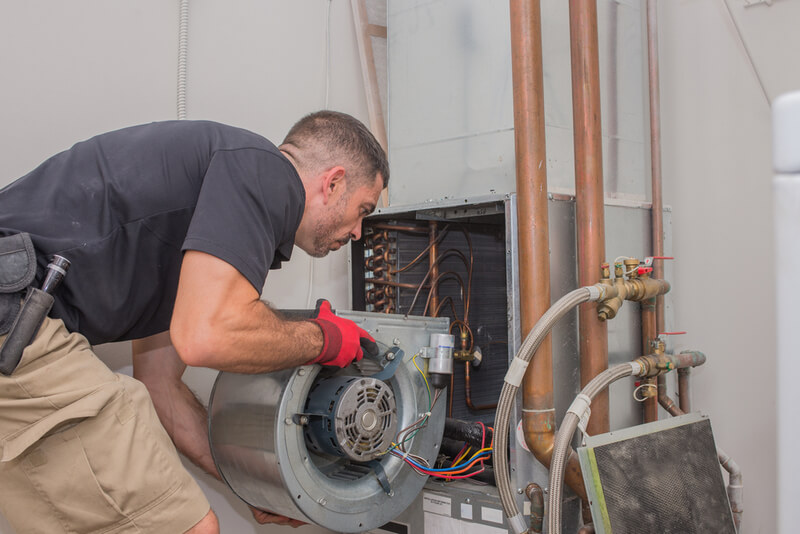Ceiling fans are a great way to keep your house cool and well ventilated. You can find ceiling fans in almost all the rooms of some houses. However, whether you should put a ceiling fan in the kitchen or not remains a debate.
Some people have a functional fan in every room of the house, including their kitchen, while others avoid them at all costs. The reason behind it is that it comes with its own pros and cons.
If you are thinking of installing a kitchen ceiling fan, you are at the right place. Keep on reading to find out whether you should go for a fan in the kitchen or not!
5 Important Reasons Why You Should Put a Ceiling Fan in Your Kitchen
There are many benefits of installing a kitchen ceiling fan, especially if you have a bigger room. Here’s why:
1. Improves Air Circulation
If you do not have proper ventilation in your kitchen, then getting a ceiling fan is a great idea. It instantly improves the room’s temperature and makes your time in the kitchen a lot more bearable.
Your kitchen can be filled with smoke, odors, and heat while cooking. So, having proper air circulation is essential for better health and cooking experience. With a cool and steady airflow, you can feel relaxed while preparing a meal.
Not only does it make your experience comfortable, but it also helps prevent coughing and sneezing due to the accumulation of smoke and spices.
2. Gets Rid of Odors
The delicious aroma of your meals can start to feel a bit uncomfortable if the smell lingers around. Especially when you are using a lot of herbs and spices, it can become really hard to breathe in the constant odor.
A kitchen fan running at a medium speed while cooking can eliminate such odors from your kitchen. As mentioned above, it can instantly increase the airflow and provide better ventilation.
It will also get rid of any smoke build-up along with the odors. However, if we talk about health, continuous strong odors can also cause a burning sensation in your nose. You can avoid this by installing a kitchen ceiling fan.
3. Lowers Electricity Bills
Turning a ceiling fan on will not directly lower your electricity bill. But, it will give you enough air circulation that you won’t have to turn your air conditioner on.
An air conditioner uses roughly 5 to 9 times more electricity than a conventional fan. This means using a ceiling fan is a better way to save money on your monthly electricity bills.
No, a ceiling fan won’t keep your body cool during a heatwave. But you can always rely on a fan during milder days to keep your house and your body cool.
Related: How Much Watts Does a Ceiling Fan Use
4. Keeps Flies at Bay
Since the ceiling fan helps circulate the air efficiently, it will keep the flies and pests away from your food. So whether you are trying to get rid of fruit flies, mosquitoes, or other small flying insects, you can fight them off by simply turning on the fan.
These insects prefer calmer air conditions, so the strong gusts of wind from your fan will work as an insect repellent. In addition, it will help your food stay fresh and free from any contaminants for a long time.
5. Provides Lighting Upgrade
If your kitchen lacks natural illumination or has fewer lighting fixtures in the area, then having a fan will give you that extra space. Yes, you can use that electricity outlet for kitchen chandeliers with light, but that will only serve one purpose, right?
With a ceiling fan, you can have a well aired-out kitchen that also has enough lighting. In addition, you can choose from the different fan style options available in the market with beautiful lighting fixtures.
Read Also: How to Troubleshoot a Ceiling Fan Light
Disadvantages of Installing a Ceiling Fan in the Kitchen
There are also a few disadvantages that you can face if you put a ceiling fan in the kitchen:
Might Accumulate Grease
One of the biggest disadvantages of having a ceiling fan is the accumulation of grease on its blades. In addition, these fans require constant upkeep that can be quite impossible if you have a busy routine.
People who use a lot of spices and oils in their food often complain about color and grease build-up on the fan. It gives a dirty and unkempt appearance to your kitchen.
Apart from that, the fan blades can also pile up a lot of dust. If you don’t clean your fans frequently, dust particles can contaminate your food every time you turn the fan on.
Related: Step by Step Guide to Oil a Ceiling Fan Without Taking It Down
Creates Noise
When they are not properly installed, ceiling fans tend to make an annoying noise that can be quite irritating and distracting. These fans often make the sound while rotating and also due to loose bolts. Constant noise also indicates that a certain part of the fan is damaged.
It can simply be fixed if you hire a professional for proper installation. Then, with proper maintenance, you can avoid this constant noise. However, it can be quite a time-taking job.
If you are someone who is easily bothered by constant background noise, then a ceiling fan is not the right fit for your kitchen.
Not Suitable for Gas Stoves
Since a gas stove makes your house even hotter compared to an electric stove, you may think that it is necessary to install a fan in that case.
Gas stoves tend to fill the area with odors and smells that you might want to get rid of but choosing a ceiling fan for this purpose will only make the situation worse.
The flowing air from the fan wouldn’t let the stovetop stay lit, leaving your food undercooked. In addition, it will indirectly increase your time in the kitchen as it will require hours to fully prepare the food.
So, what’s the point if you can’t even cook in your kitchen? It may be suitable for electric stoves, but if you have a gas stove, getting a ceiling fan can be a mistake.
Tricky Installation Process
The process to install a ceiling fan in your kitchen can be hectic since you need to check up on a few very important factors, including the electric connection, before hanging up the fan.
Check the attic or crawlspace on the ceiling for proper space and connection. If you don’t have an electric connection on the ceiling, you will have to hire an electrician to tweak the wiring a little.
The height of your ceiling is another crucial thing to note before the installation since it is best to hang the fan at a distance of eight feet above you. If the ceiling is too high, you’ll need a rod attached to the fan.
You May Also Like: Will a Humidifier Make the Room Cooler
Tips on Selecting Kitchen Ceiling Fans
If you have decided to put a ceiling fan in the kitchen, then there are a few tips you need to consider while selecting:
Blade Sizes Matters
When installing a kitchen ceiling fan, you need to be careful about the space, especially when you’re getting it in the kitchen.
The blades of your fan should not interfere with the lights or cabinetry of your kitchen, which requires you to get small-size blades that are appropriate for the area of your kitchen.
Keeping the size on the checklist will not only give you a safe installation but also ensure a balanced look according to the kitchen space.
User-Friendly Controls
You may want to pick a smaller fan, but not with any fewer functions and controls. Instead, get a ceiling fan that has seasonal settings and smart controls to make your life easy and comfortable.
Get the one with a powerful and adjustable lighting system according to your needs, and the speed should also be controllable. Consider the one with better airflow, and if required, the remote control is also a convenient tool to care for.
Don’t forget to check whether the ceiling fan you have chosen has an AC or DC motor. Although AC motors are common, a fan with a DC motor will be a lot more energy-efficient and noise-free.
Color and Style
Speaking of important factors, choosing a ceiling fan with the right color and design must be included on the list. Also, you don’t want to get a fan that doesn’t go with the theme of your kitchen.
Choose the one that gets along with the colors and design of your kitchen so it doesn’t look like the odd one out. The purpose is to upgrade your kitchen, not downgrade it.
Look out for a fan with a simple design that is easier to clean and beautiful to look at. The design or colors of a fan may not seem important, but it affects the overall appearance of your kitchen.
Read Also: How Much Does a Ceiling Fan Weigh
Conclusion: Ceiling Fan in the Kitchen — Yes or No?
Whether you need a ceiling fan or not depends on the design of your kitchen. If your kitchen is well-ventilated and has enough light, installing a kitchen ceiling fan is unnecessary. Even if you want to get rid of flies and pests, you can use a pedestal fan for that purpose.
However, if you have a bigger kitchen with less ventilation and illumination, then getting a ceiling fan is a good idea. You need to weigh the advantages and disadvantages of having a ceiling fan before investing your money.







